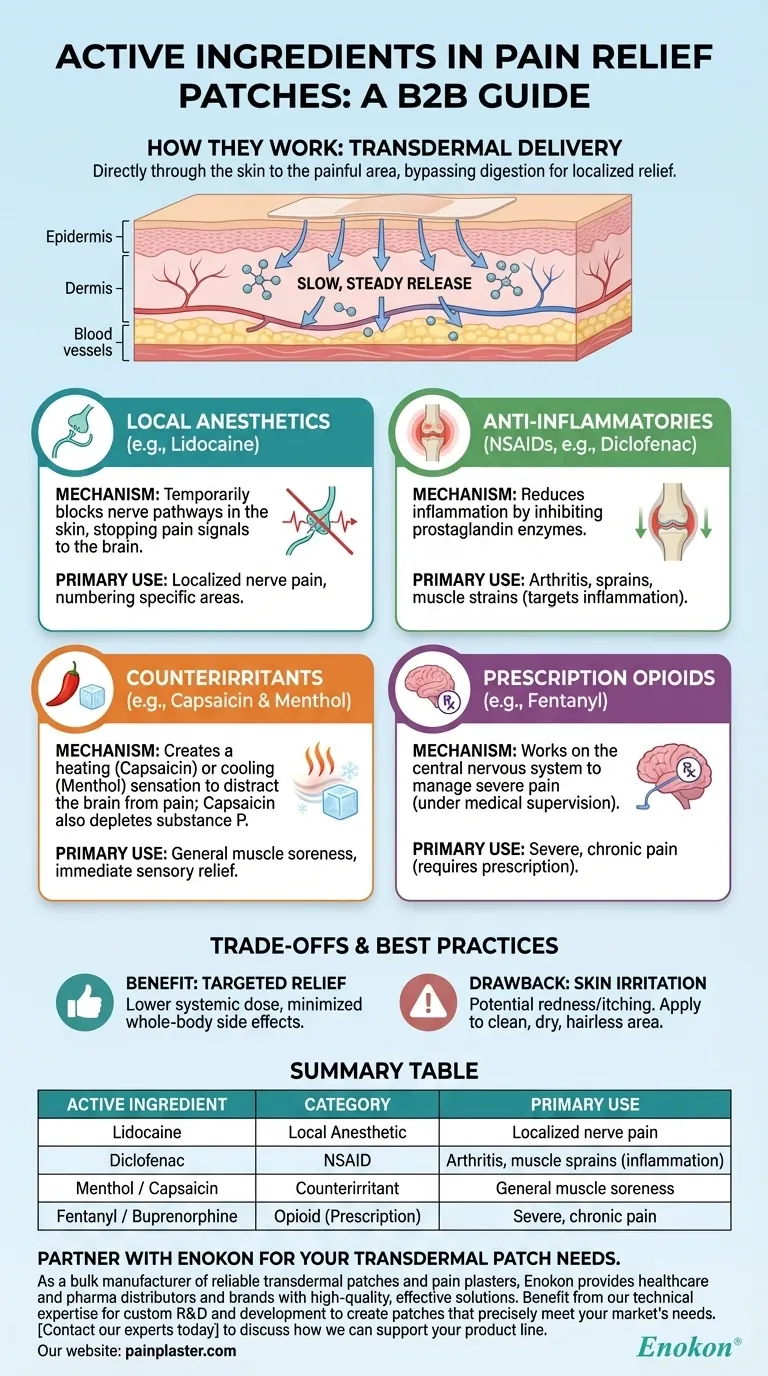The most common active ingredients in pain relief patches fall into three primary categories: local anesthetics like lidocaine, which numb the area; nonsteroidal anti-inflammatory drugs (NSAIDs), which reduce inflammation; and counterirritants like capsaicin and menthol, which create a heating or cooling sensation to override pain signals. For severe chronic pain, prescription patches may also contain opioids like fentanyl.
Pain relief patches are not a one-size-fits-all solution. Their effectiveness depends entirely on matching the right active ingredient's mechanism of action to the specific source of your pain, whether it's nerve-related, inflammatory, or muscular.

How Patches Deliver Targeted Relief
The Principle of Transdermal Delivery
Pain relief patches are adhesive pads that deliver medication directly through the skin to the painful area. This is known as transdermal delivery.
This method allows for a slow, steady release of the active ingredient over several hours or even days. It bypasses the digestive system, which can reduce the systemic side effects often associated with oral pain medications.
Decoding the Active Ingredients: A Mechanism-Based Guide
The ingredient inside the patch is what determines how it works. Understanding these differences is key to choosing the right product.
Local Anesthetics (Lidocaine)
Lidocaine is a local anesthetic that works by temporarily blocking nerve pathways in the skin. This stops the nerves from sending pain signals to your brain, effectively numbing the specific area where the patch is applied.
It is most effective for localized nerve pain.
Anti-Inflammatories (NSAIDs)
NSAIDs, such as diclofenac, work by reducing inflammation at the source of the pain. They inhibit the production of enzymes called prostaglandins, which are key contributors to inflammation, swelling, and pain.
These patches are ideal for conditions like arthritis, sprains, and muscle strains where inflammation is a primary symptom.
Counterirritants (Capsaicin & Menthol)
These ingredients work by creating a different sensation on the skin to distract your brain from the underlying pain.
Menthol produces a cooling sensation, while capsaicin (derived from chili peppers) creates a feeling of heat. Capsaicin also has a deeper effect, depleting a chemical known as substance P, which is involved in transmitting pain signals.
A Note on Prescription Opioids
Opioids like fentanyl and buprenorphine are powerful pain relievers available only by prescription. They work on the central nervous system to manage severe, chronic pain and are used under strict medical supervision due to their potency and potential for misuse.
Understanding the Trade-offs and Best Practices
While effective, patches require proper use to be safe and deliver results.
The Benefit: Targeted vs. Systemic Relief
The main advantage of a patch is localized relief. By applying the medication directly where it hurts, you can often use a lower overall dose and minimize effects on the rest of your body compared to taking a pill.
The Drawback: Potential for Skin Irritation
The adhesive and active ingredients can sometimes cause redness, itching, or irritation. It is crucial to apply the patch to a clean, dry, and hairless area that is free from cuts or existing irritation.
The Importance of Safe Application and Disposal
Always follow the manufacturer's instructions for how long to wear the patch. When you remove it, fold the sticky sides together and dispose of it safely, out of the reach of children and pets, as even used patches can contain residual medication.
Making the Right Choice for Your Pain
To select the best patch, match the ingredient to your type of pain.
- If your primary focus is sharp, localized nerve pain: A lidocaine patch is designed to directly numb the nerve signals causing the discomfort.
- If your primary focus is arthritis or a muscle sprain: An NSAID patch targets the underlying inflammation, providing relief from swelling and pain.
- If your primary focus is general muscle soreness: A menthol or capsaicin patch can provide immediate sensory relief and help soothe the area.
- If your primary focus is severe, persistent pain: You must consult a healthcare professional to determine if a prescription-strength option is appropriate.
By understanding how these ingredients work, you can select a patch that directly addresses the root cause of your discomfort.
Summary Table:
| Active Ingredient | Category | Primary Use |
|---|---|---|
| Lidocaine | Local Anesthetic | Localized nerve pain |
| Diclofenac | NSAID | Arthritis, muscle sprains (inflammation) |
| Menthol / Capsaicin | Counterirritant | General muscle soreness |
| Fentanyl / Buprenorphine | Opioid (Prescription) | Severe, chronic pain |
Partner with Enokon for Your Transdermal Patch Needs
As a bulk manufacturer of reliable transdermal patches and pain plasters, Enokon provides healthcare and pharma distributors and brands with high-quality, effective solutions. Benefit from our technical expertise for custom R&D and development to create patches that precisely meet your market's needs.
Contact our experts today to discuss how we can support your product line.
Visual Guide

Related Products
- Far Infrared Deep Heat Relief Patches Medicated Pain Relief Patches
- Capsaicin Chili Medicated Pain Relief Patches
- Icy Hot Menthol Medicine Pain Relief Patch
- Menthol Gel Pain Relief Patch
- Far Infrared Heat Pain Relief Patches Transdermal Patches
People Also Ask
- How do pain relief patches compare to other pain relief methods? Discover Targeted, Long-Lasting Relief
- How should pain relief patches be applied and used? A Guide to Safe & Effective Targeted Relief
- How do pain relief patches work? A Guide to Targeted, Long-Lasting Pain Relief
- How do Deep Heat Pain Relief Patches provide pain relief? Discover the Drug-Free Mechanism
- How often should pain relief patches be used? Get the Right Schedule for Targeted Relief
















